Unraveling the Ecological Tapestry: A Comprehensive Assessment of Changtang Nature Reserve’s Ecological and Environmental Using RSEI and GEE
Abstract
:1. Introduction
2. Materials and Methods
2.1. Study Area
2.2. Data Source and Preprocessing
2.3. Construction of RSEI Index
2.3.1. Calculation of Four-Component Indicators
- Greenness
- Wetness
- Heat
- Dryness
2.3.2. Savitzky-Golay Filter
2.3.3. Principal Component Analysis
3. Results
3.1. Results of Principal Component Analysis
3.2. Analysis of Temporal Changes in the Quality of the Ecological Environment
3.3. RSEI Transfer Analysis
4. Discussion
5. Conclusions
Author Contributions
Funding
Data Availability Statement
Conflicts of Interest
Appendix A
| Year | Sensors | Acquisition Date |
|---|---|---|
| 2000 | MOD09A1 MOD11A2 | 3 July 2000; 11 July 2000; 19 July 2000; 27 July 2000; 4 August 2000; 12 August 2000; 20 August 2000; 28 August 2000; 5 September 2000; 13 September 2000; 21 September 2000; 29 September 2000 |
| MOD13A1 | 11 July 2000; 27 July 2000; 12 August 2000; 28 August 2000; 13 September 2000; 29 September 2000 | |
| 2005 | MOD09A1 MOD11A2 | 4 July 2000; 12 July 2000; 20 July 2000; 28 July 2000; 5 August 2000; 13 August 2000; 21 August 2000; 29 August 2000; 6 September 2000; 14 September 2000; 22 September 2000 |
| MOD13A1 | 12 July 2000; 28 July 2000; 13 August 2000; 29 August 2000; 14 September 2000 | |
| 2010 | MOD09A1 MOD11A2 | 4 July 2000; 12 July 2000; 20 July 2000; 28 July 2000; 5 August 2000; 13 August 2000; 21 August 2000; 29 August 2000; 6 September 2000; 14 September 2000; 22 September 2000 |
| MOD13A1 | 12 July 2000; 28 July 2000; 13 August 2000; 29 August 2000; 14 September 2000 | |
| 2015 | MOD09A1 MOD11A2 | 4 July 2000; 12 July 2000; 20 July 2000; 28 July 2000; 5 August 2000; 13 August 2000; 21 August 2000; 29 August 2000; 6 September 2000; 14 September 2000; 22 September 2000 |
| MOD13A1 | 12 July 2000; 28 July 2000; 13 August 2000; 29 August 2000; 14 September 2000 | |
| 2020 | MOD09A1 MOD11A2 | 3 July 2000; 11 July 2000; 19 July 2000; 27 July 2000; 4 August 2000; 4 August 2000; 12 August 2000; 20 August 2000; 28 August 2000; 5 September 2000; 13 September 2000; 21 September 2000; 29 September 2000 |
| MOD13A1 | 11 July 2000; 27 July 2000; 12 August 2000; 28 August 2000; 13 September 2000; 29 September 2000 |
References
- Liangliang, Y. The Geographic Characteristics Analysis of the National Key Protected Vertebrates and National Nature Reserves in China. Master’s Thesis, Beijing Forestry University, Beijing, China, 1 December 2009. [Google Scholar]
- Xiaoping, W.; Wunian, Y.; Guoming, L. Research on NDVl temporal and spatial variation of Qiangtang National Nature Reserve. Sci. Surv. Mapp. 2014, 85, 2071–2079. [Google Scholar] [CrossRef]
- Jun, D.; Xiaojun, N.; Lei, Y.; Dunzhu, C. Climatic and environmental features in Chang Tang National Nature Reserve during 1971–2017. J. Glaciol. Geocryol. 2020, 42, 1017–1026. [Google Scholar]
- Wang, R.; Feng, Q.; Jin, Z.; Liang, T. The restoration potential of the grasslands on the tibetan plateau. Remote Sens. 2022, 14, 80. [Google Scholar] [CrossRef]
- Yang, L.; Zhao, G.; Mu, X.; Lan, Z.; Jiao, J.; An, S.; Wu, Y.; Miping, P. Integrated assessments of land degradation on the Qinghai-Tibet plateau. Ecol. Indic. 2023, 147, 109945. [Google Scholar] [CrossRef]
- Li, M.; Weng, B.; Yan, D.; Bi, W.; Wang, H. Variation trends and attribution analysis of lakes in the Qiangtang Plateau, the Endorheic Basin of the Tibetan Plateau. Sci. Total Environ. 2022, 837, 155595. [Google Scholar] [CrossRef] [PubMed]
- Dunzhu, C.; Jun, D.; Cuojie, D. Spatial-temporal Change of Consecutive Dry Days in Changtang National Nature Reserve of Tibet During 1971–2017. Chin. Agric. Sci. Bull. 2018, 34, 118–122. [Google Scholar]
- Jun, Z.; Lei, S.; Dunzhu, C. Response of Snow Cover to Climate Change in Chang Tang Nature Reserve in 1971–2017. Chin. Agric. Sci. Bull. 2019, 35, 130–138. [Google Scholar]
- Jun, D.; Kanshe, Z.; Duzhu, C. Spatial and temporal variations of surface soil freezing days in Chang Tang Natural Reserve of Tibet during 1981–2018. Chin. J. Ecol. 2020, 39, 1121–1129. [Google Scholar]
- Lei, Y.; Kanshe, Z.; Dongdong, Z. Spatial-temporal Variation of NDVI in the Vegetation Growing Season of Changtang National Nature Reserve and Its Response to Climate Change. Chin. Agric. Sci. Bull. 2022, 38, 127–134. [Google Scholar]
- Urban, M.; Eberle, J.; Hüttich, C.; Schmullius, C.; Herold, M. Comparison of satellite-derived land surface temperature and air temperature from meteorological stations on the pan-arctic scale. Remote Sens. 2013, 5, 2348–2367. [Google Scholar] [CrossRef] [Green Version]
- Wang, F.; Yang, H.; Wang, Z.; Zhang, Z.; Li, Z. Drought evaluation with CMORPH satellite precipitation data in the Yellow River basin by using Gridded Standardized Precipitation Evapotranspiration Index. Remote Sens. 2019, 11, 485. [Google Scholar] [CrossRef] [Green Version]
- Ramírez-Cuesta, J.M.; Cruz-Blanco, M.; Santos, C.; Lorite, I.J. Assessing reference evapotranspiration at regional scale based on remote sensing, weather forecast and GIS tools. Int. J. Appl. Earth Obs. Geoinf. 2017, 55, 32–42. [Google Scholar] [CrossRef]
- Wang, F.; Wang, Z.; Yang, H.; Zhao, Y.; Li, Z.; Wu, J. Capability of remotely sensed drought indices for representing the spatio-temporal variations of the meteorological droughts in the Yellow River basin. Remote Sens. 2018, 10, 1834. [Google Scholar] [CrossRef] [Green Version]
- Sishodia, R.P.; Ray, R.L.; Singh, S.K. Applications of remote sensing in precision agriculture: A review (Indices vegetativos utilizados na agricultura). Remote Sens. 2020, 12, 3136. [Google Scholar] [CrossRef]
- Maurya, K.; Mahajan, S.; Chaube, N. Remote sensing techniques: Mapping and monitoring of mangrove ecosystem—A review. Complex Intell. Syst. 2021, 7, 2797–2818. [Google Scholar] [CrossRef]
- Shiklomanov, A.N.; Bradley, B.A.; Dahlin, K.M.; Fox, A.M.; Gough, C.M.; Hoffman, F.M.; Middleton, E.M.; Serbin, S.P.; Smallman, L.; Smith, W.K. Enhancing global change experiments through integration of remote-sensing techniques. Front. Ecol. Environ. 2019, 17, 215–224. [Google Scholar] [CrossRef] [Green Version]
- Pettorelli, N.; Schulte to Bühne, H.; Tulloch, A.; Dubois, G.; Macinnis-Ng, C.; Queirós, A.M.; Keith, D.A.; Wegmann, M.; Schrodt, F.; Stellmes, M.; et al. Satellite remote sensing of ecosystem functions: Opportunities, challenges and way forward. Remote Sens. Ecol. Conserv. 2018, 4, 71–93. [Google Scholar] [CrossRef]
- Song, Y.; Wu, C. Examining human heat stress with remote sensing technology. GIScience Remote Sens. 2018, 55, 19–37. [Google Scholar] [CrossRef]
- Murray, N.J.; Keith, D.A.; Bland, L.M.; Ferrari, R.; Lyons, M.B.; Lucas, R.; Pettorelli, N.; Nicholson, E. The role of satellite remote sensing in structured ecosystem risk assessments. Sci. Total Environ. 2018, 619–620, 249–257. [Google Scholar] [CrossRef] [Green Version]
- Eddy, I.M.S.; Gergel, S.E.; Coops, N.C.; Henebry, G.M.; Levine, J.; Zerriffi, H.; Shibkov, E. Integrating remote sensing and local ecological knowledge to monitor rangeland dynamics. Ecol. Indic. 2017, 82, 106–116. [Google Scholar] [CrossRef]
- Li, K.; Zhang, B.; Xiao, W.; Lu, Y. Land Use Transformation Based on Production−Living−Ecological Space and Associated Eco-Environment Effects: A Case Study in the Yangtze River Delta Urban Agglomeration. Land 2022, 11, 1076. [Google Scholar] [CrossRef]
- Yang, Y.; Wang, L.; Yang, F.; Hu, N.; Liang, L. Evaluation of the coordination between eco-environment and socioeconomy under the “Ecological County Strategy” in western China: A case study of Meixian. Ecol. Indic. 2021, 125, 107585. [Google Scholar] [CrossRef]
- Wang, Z.; Chen, T.; Zhu, D.; Jia, K.; Plaza, A. RSEIFE: A new remote sensing ecological index for simulating the land surface eco-environment. J. Environ. Manag. 2023, 326, 116851. [Google Scholar] [CrossRef]
- Peng, J.; Zhao, Z.; Yin, G. Evaluation of urban land resource value based on sustainable environment space governance. Alex. Eng. J. 2022, 61, 5585–5593. [Google Scholar] [CrossRef]
- Wang, J.; Li, G. Eco-Environmental Effect Evaluation of Tamarix chinesis Forest on Coastal Saline-Alkali Land Based on RSEI Model. Sens. Artic. 2022, 22, 5052. [Google Scholar] [CrossRef]
- Geng, J.; Yu, K.; Xie, Z.; Zhao, G.; Ai, J.; Yang, L.; Yang, H.; Liu, J. Analysis of Spatiotemporal Variation and Drivers of Ecological Quality in Fuzhou Based on RSEI. Remote Sens. 2022, 14, 4900. [Google Scholar] [CrossRef]
- Yang, X.; Meng, F.; Fu, P.; Wang, Y.; Liu, Y. Time-frequency optimization of RSEI: A case study of Yangtze River Basin. Ecol. Indic. 2022, 141, 109080. [Google Scholar] [CrossRef]
- Yuan, B.; Fu, L.; Zou, Y.; Zhang, S.; Chen, X.; Li, F.; Deng, Z.; Xie, Y. Spatiotemporal change detection of ecological quality and the associated affecting factors in Dongting Lake Basin, based on RSEI. J. Clean. Prod. 2021, 302, 126995. [Google Scholar] [CrossRef]
- Jiang, F.; Zhang, Y.; Li, J.; Sun, Z. Research on remote sensing ecological environmental assessment method optimized by regional scale. Environ. Sci. Pollut. Res. 2021, 28, 68174–68187. [Google Scholar] [CrossRef]
- Li, J.; Liang, J.; Wu, Y.; Yin, S.; Yang, Z.; Hu, Z. Quantitative evaluation of ecological cumulative effect in mining area using a pixel-based time series model of ecosystem service value. Ecol. Indic. 2021, 120, 106873. [Google Scholar] [CrossRef]
- Fan, M.; Liao, K.; Lu, D.; Li, D. Examining Vegetation Change and Associated Spatial Patterns in Wuyishan National Park at Different Protection Levels. Remote Sens. 2022, 14, 1712. [Google Scholar] [CrossRef]
- Zheng, Z.; Wu, Z.; Chen, Y.; Guo, C.; Marinello, F. Instability of remote sensing based ecological index (RSEI) and its improvement for time series analysis. Sci. Total Environ. 2022, 814, 152595. [Google Scholar] [CrossRef]
- Hird, J.N.; McDermid, G.J. Noise reduction of NDVI time series: An empirical comparison of selected techniques. Remote Sens. Environ. 2009, 113, 248–258. [Google Scholar] [CrossRef]
- Dong, X.; Liu, B.; Yang, L.; Wang, H.; Wu, B.; Liu, R.; Chen, H.; Chen, X.; Yu, S.; Chen, B.; et al. Clinical exome sequencing as the first-tier test for diagnosing developmental disorders covering both CNV and SNV: A Chinese cohort. J. Med. Genet. 2020, 57, 558–566. [Google Scholar] [CrossRef] [Green Version]
- Sajadi, P.; Sang, Y.F.; Gholamnia, M.; Bonafoni, S.; Brocca, L.; Pradhan, B.; Singh, A. Performance evaluation of long ndvi timeseries from avhrr, modis and landsat sensors over landslide-prone locations in qinghai-tibetan plateau. Remote Sens. 2021, 13, 3172. [Google Scholar] [CrossRef]
- Liu, R.; Shang, R.; Liu, Y.; Lu, X. Global evaluation of gap-filling approaches for seasonal NDVI with considering vegetation growth trajectory, protection of key point, noise resistance and curve stability. Remote Sens. Environ. 2017, 189, 164–179. [Google Scholar] [CrossRef] [Green Version]
- Sakamoto, T.; Yokozawa, M.; Toritani, H.; Shibayama, M.; Ishitsuka, N.; Ohno, H. A crop phenology detection method using time-series MODIS data. Remote Sens. Environ. 2005, 96, 366–374. [Google Scholar] [CrossRef]
- Vuolo, F.; Ng, W.T.; Atzberger, C. Smoothing and gap-filling of high resolution multi-spectral time series: Example of Landsat data. Int. J. Appl. Earth Obs. Geoinf. 2017, 57, 202–213. [Google Scholar] [CrossRef]
- Julien, Y.; Sobrino, J.A. Comparison of cloud-reconstruction methods for time series of composite NDVI data. Remote Sens. Environ. 2010, 114, 618–625. [Google Scholar] [CrossRef]
- Chen, J.; Jönsson, P.; Tamura, M.; Gu, Z.; Matsushita, B.; Eklundh, L. A simple method for reconstructing a high-quality NDVI time-series data set based on the Savitzky-Golay filter. Remote Sens. Environ. 2004, 91, 332–344. [Google Scholar] [CrossRef]
- Mingwei, Z.; Qingbo, Z.; Zhongxin, C.; Jia, L.; Yong, Z.; Chongfa, C. Crop discrimination in Northern China with double cropping systems using Fourier analysis of time-series MODIS data. Int. J. Appl. Earth Obs. Geoinf. 2008, 10, 476–485. [Google Scholar] [CrossRef]
- Roerink, G.J.; Menenti, M.; Verhoef, W. Reconstructing cloudfree NDVI composites using Fourier analysis of time series. Int. J. Remote Sens. 2000, 21, 1911–1917. [Google Scholar] [CrossRef]
- Aizizi, Y.; Kasimu, A.; Liang, H.; Zhang, X.; Zhao, Y.; Wei, B. Evaluation of ecological space and ecological quality changes in urban agglomeration on the northern slope of the Tianshan Mountains. Ecol. Indic. 2023, 146, 109896. [Google Scholar] [CrossRef]
- Xiong, Y.; Xu, W.; Lu, N.; Huang, S.; Wu, C.; Wang, L.; Dai, F.; Kou, W. Assessment of spatial–temporal changes of ecological environment quality based on RSEI and GEE: A case study in Erhai Lake Basin, Yunnan province, China. Ecol. Indic. 2021, 125, 107518. [Google Scholar] [CrossRef]
- Liu, Z.; Wang, L.; Li, B. Quality Assessment of Ecological Environment Based on Google Earth Engine: A Case Study of the Zhoushan Islands. Front. Ecol. Evol. 2022, 10, 918756. [Google Scholar] [CrossRef]
- Yan, Y.; Zhuang, Q.; Zan, C.; Ren, J.; Yang, L.; Wen, Y.; Zeng, S.; Zhang, Q.; Kong, L. Using the Google Earth Engine to rapidly monitor impacts of geohazards on ecological quality in highly susceptible areas. Ecol. Indic. 2021, 132, 108258. [Google Scholar] [CrossRef]
- Klisch, A.; Atzberger, C. Operational drought monitoring in Kenya using MODIS NDVI time series. Remote Sens. 2016, 8, 267. [Google Scholar] [CrossRef] [Green Version]
- Crist, E.P. A TM Tasseled Cap equivalent transformation for reflectance factor data. Remote Sens. Environ. 1985, 17, 301–306. [Google Scholar] [CrossRef]
- Nichol, J. Remote sensing of urban heat islands by day and night. Photogramm. Eng. Remote Sens. 2005, 71, 613–621. [Google Scholar] [CrossRef]
- Liu, Y.; Meng, Q.; Zhang, L.; Wu, C. NDBSI: A normalized difference bare soil index for remote sensing to improve bare soil mapping accuracy in urban and rural areas. Catena 2022, 214, 106265. [Google Scholar] [CrossRef]
- Sur, K.; Dave, R.; Chauhan, P. Spatio—Temporal changes in NDVI and rainfall over Western Rajasthan and Gujarat region of India. J. Agrometeorol. 2018, 20, 189–195. [Google Scholar]
- Xu, H. Modification of normalised difference water index (NDWI) to enhance open water features in remotely sensed imagery. Int. J. Remote Sens. 2006, 27, 3025–3033. [Google Scholar] [CrossRef]
- Xie, F.; Fan, H. Deriving drought indices from MODIS vegetation indices (NDVI/EVI) and Land Surface Temperature (LST): Is data reconstruction necessary? Int. J. Appl. Earth Obs. Geoinf. 2021, 101, 102352. [Google Scholar] [CrossRef]
- Wan, W.; Liu, Z.; Li, K.; Wang, G.; Wu, H.; Wang, Q. Drought monitoring of the maize planting areas in Northeast and North China Plain. Agric. Water Manag. 2021, 245, 106636. [Google Scholar] [CrossRef]
- Abdi, H.; Williams, L.J. Principal component analysis. wiley interdisciplinary reviews: Computational statistics. Wiley Interdisplinary Rev. Comput. Stat. 2010, 2, 433–459. [Google Scholar] [CrossRef]
- Johnstone, I.M.; Paul, D. PCA in High Dimensions: An Orientation. Proc. IEEE 2018, 106, 1277–1292. [Google Scholar] [CrossRef]
- Xiu, Y.; Liu, W.; Yang, W. An Improved Rotation Forest for Multi-Feature Remote-Sensing Imagery Classification. Remote Sens. 2017, 9, 1205. [Google Scholar] [CrossRef] [Green Version]
- Gewers, F.L.; Ferreira, G.R.; De Arruda, H.F.; Silva, F.N.; Comin, C.H.; Amancio, D.R.; Costa, L.D.F. Principal component analysis: A natural approach to data exploration. ACM Comput. Surv. 2021, 54, 3447755. [Google Scholar] [CrossRef]
- Wakulinśka, M.; Marcinkowska-Ochtyra, A. Multi-temporal sentinel-2 data in classification of mountain vegetation. Remote Sens. 2020, 12, 2696. [Google Scholar] [CrossRef]
- Oteros, J.; García-Mozo, H.; Vázquez, L.; Mestre, A.; Domínguez-Vilches, E.; Galán, C. Modelling olive phenological response to weather and topography. Agric. Ecosyst. Environ. 2013, 179, 62–68. [Google Scholar] [CrossRef]
- Liu, Q.; Zhang, Y.; Liu, L.; Li, L.; Qi, W. The spatial local accuracy of land cover datasets over the Qiangtang Plateau, High Asia. J. Geogr. Sci. 2019, 29, 1841–1858. [Google Scholar] [CrossRef] [Green Version]
- Zhang, G.; Zhang, Y.; Dong, J.; Xiao, X. Green-up dates in the Tibetan Plateau have continuously advanced from 1982 to 2011. Proc. Natl. Acad. Sci. USA 2013, 110, 4309–4314. [Google Scholar] [CrossRef]
- Cao, J.; Wu, E.; Wu, S.; Fan, R.; Xu, L.; Ning, K.; Li, Y.; Lu, R.; Xu, X.; Zhang, J.; et al. Spatiotemporal Dynamics of Ecological Condition in Qinghai-Tibet Plateau Based on Remotely Sensed Ecological Index. Remote Sens. 2022, 14, 4234. [Google Scholar] [CrossRef]
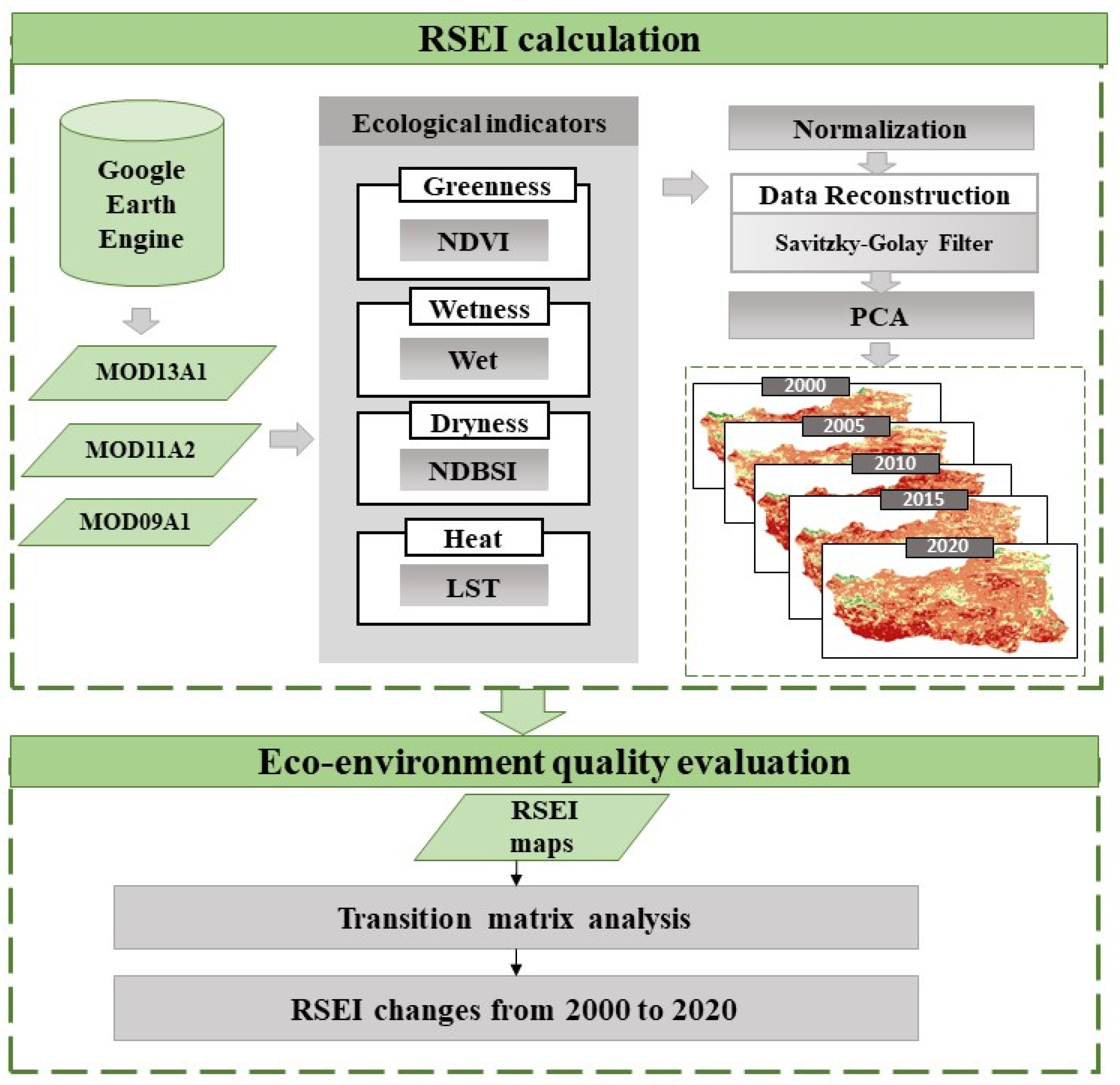
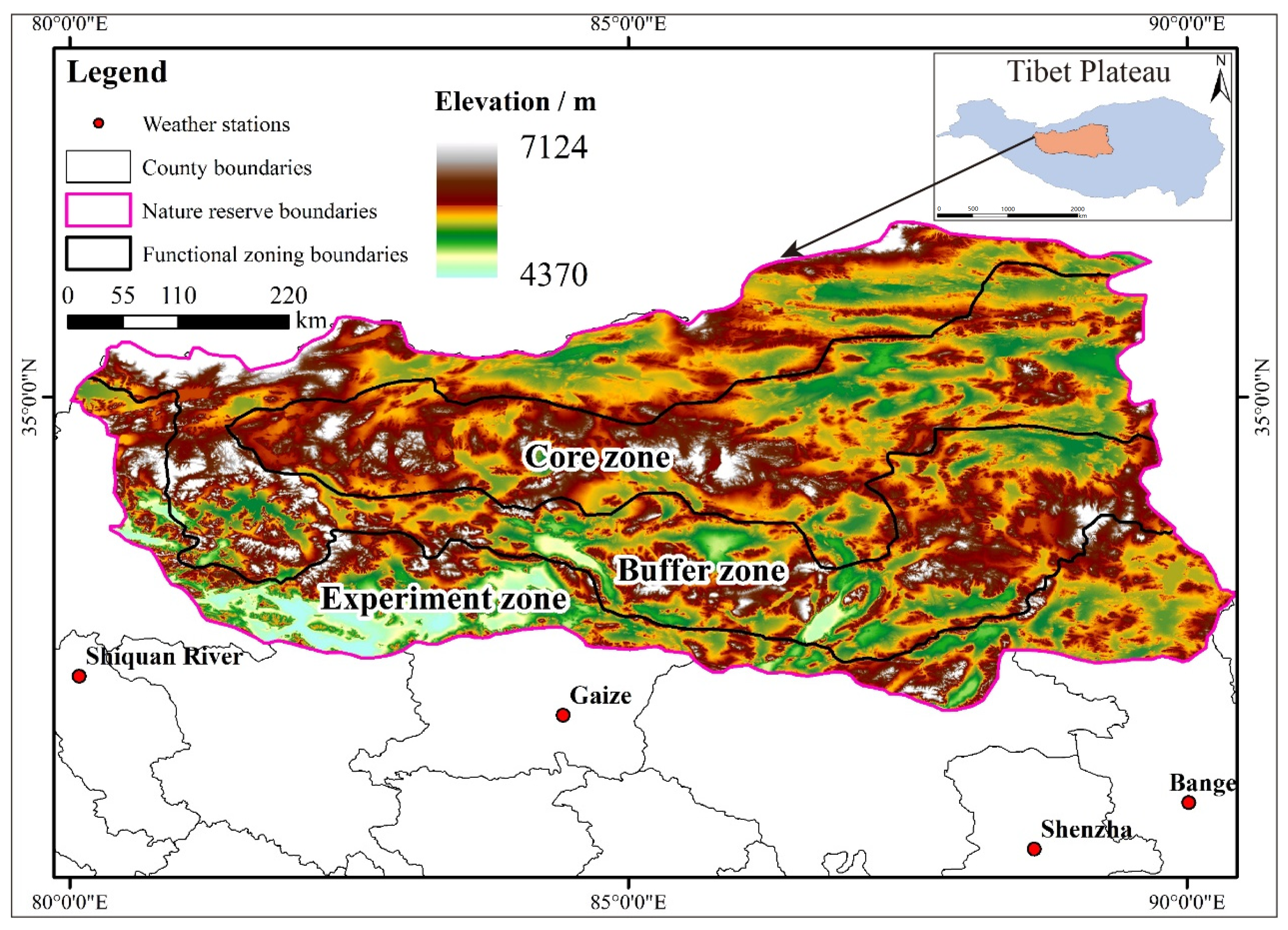
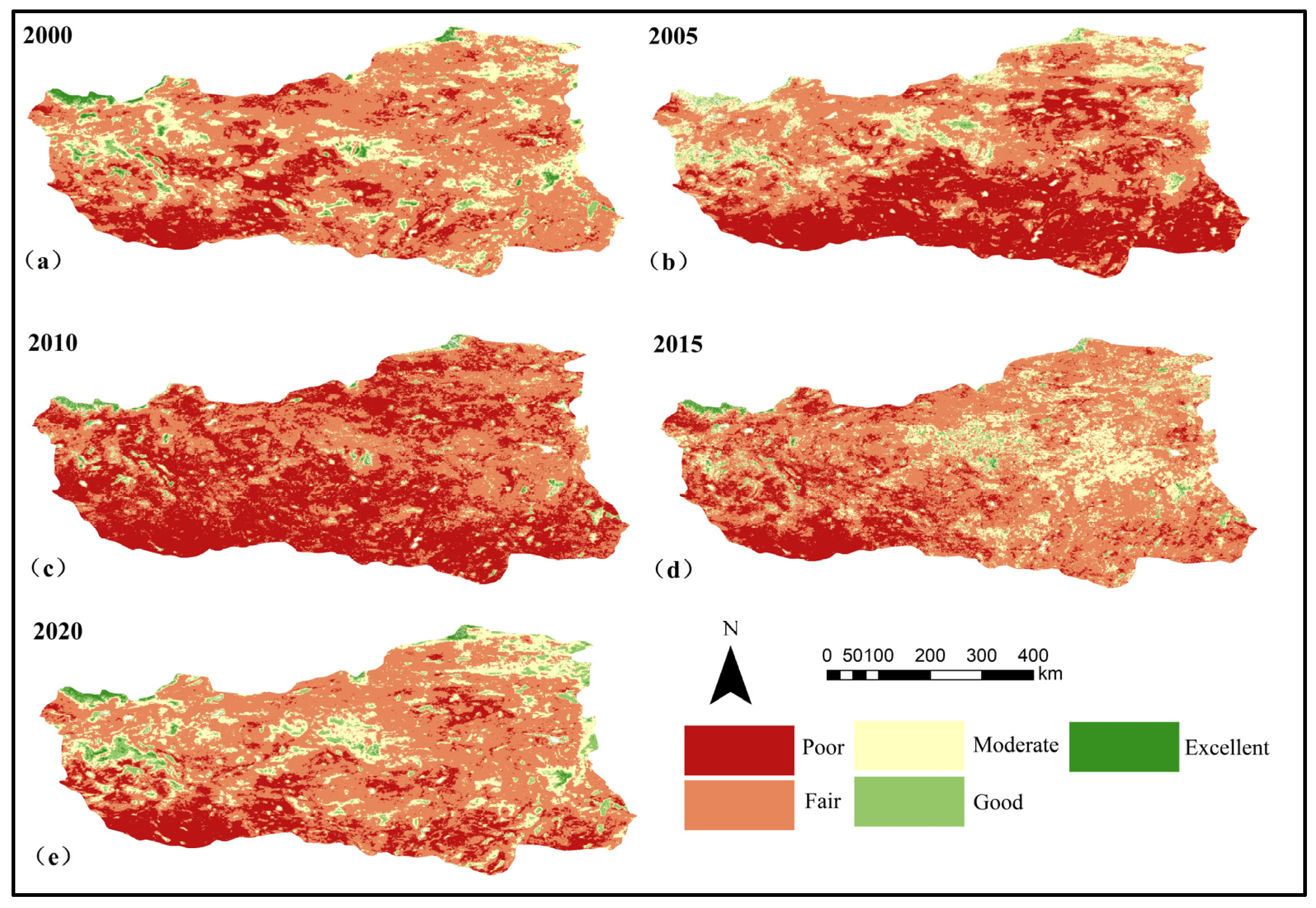
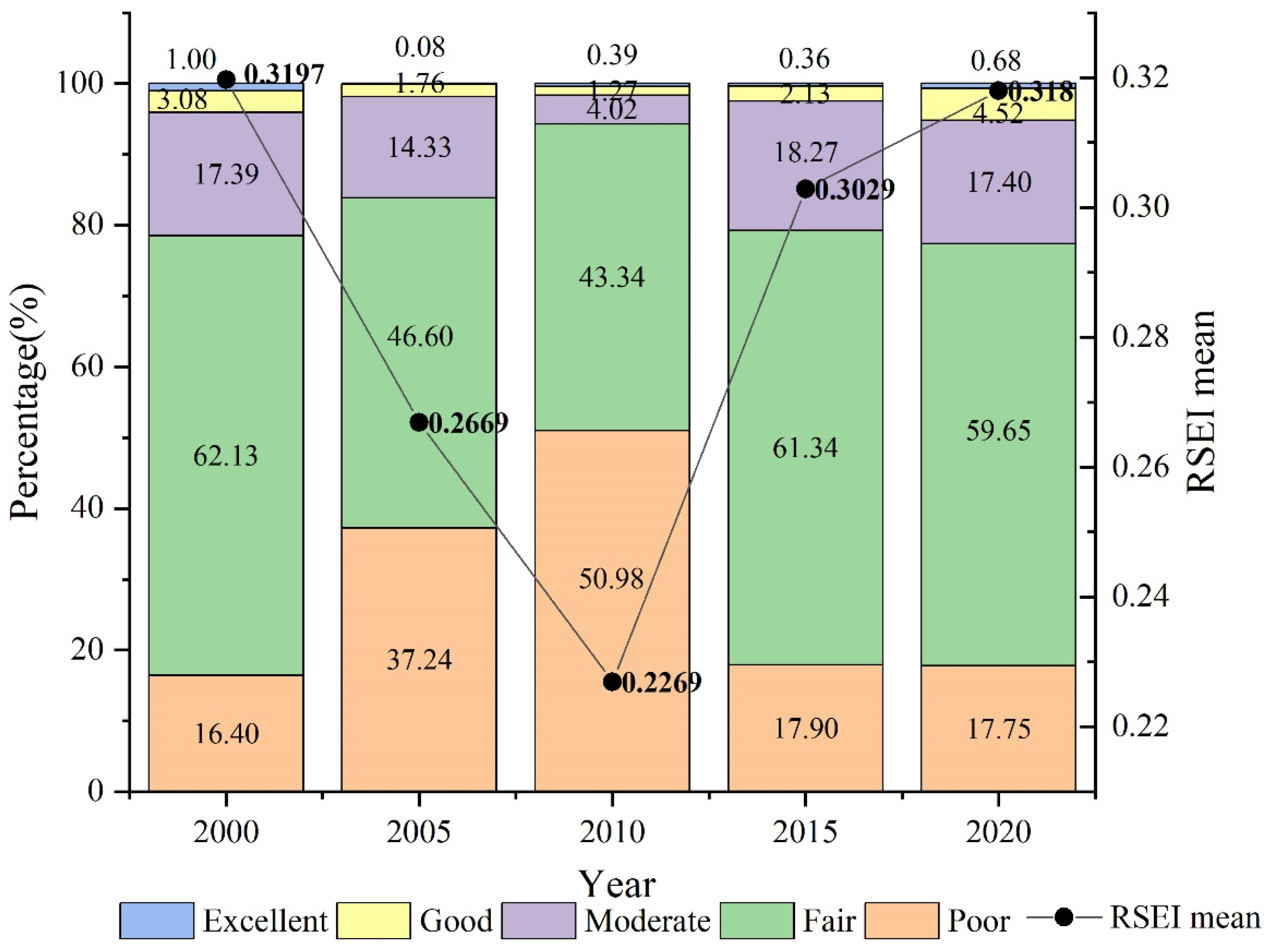
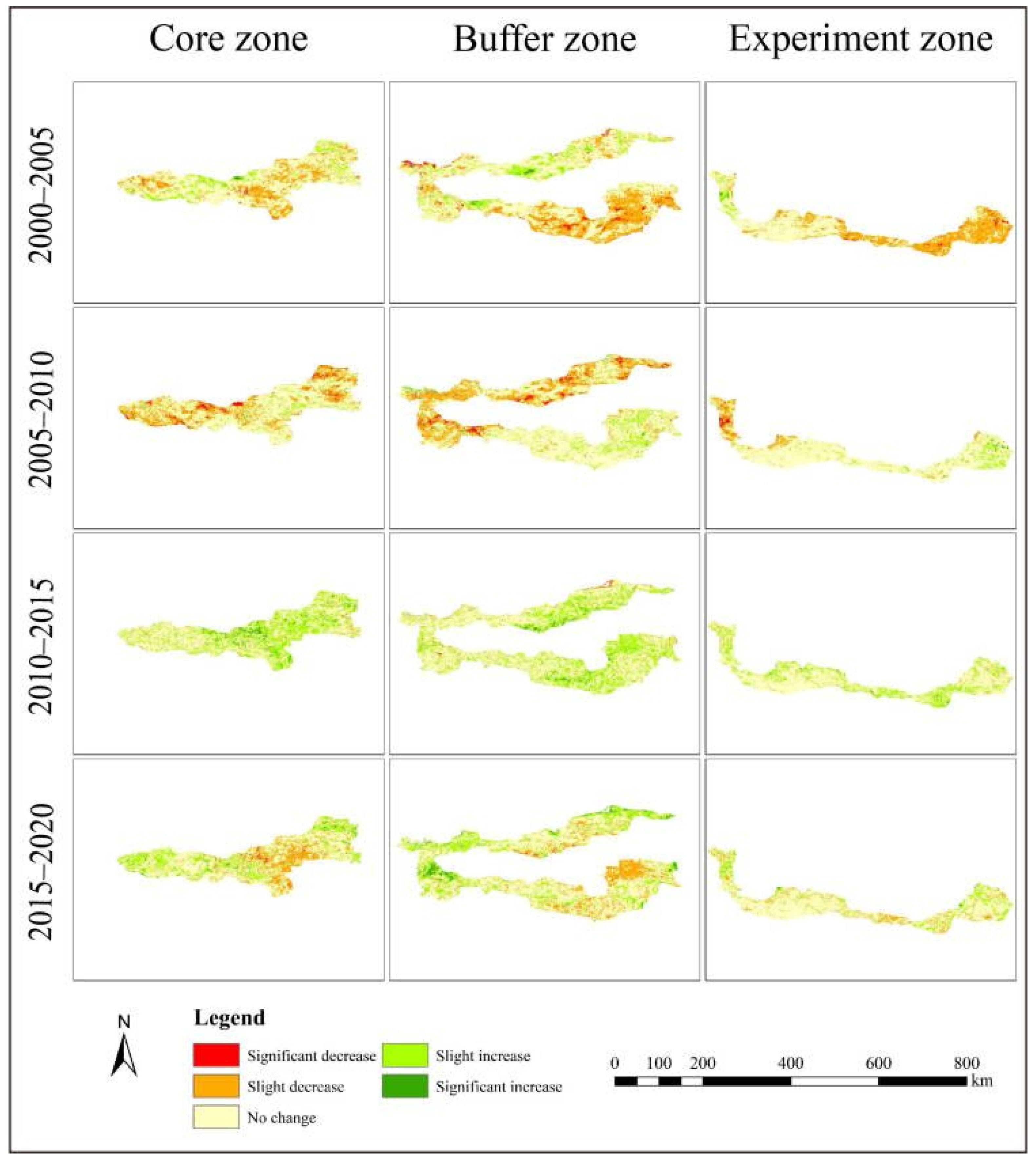
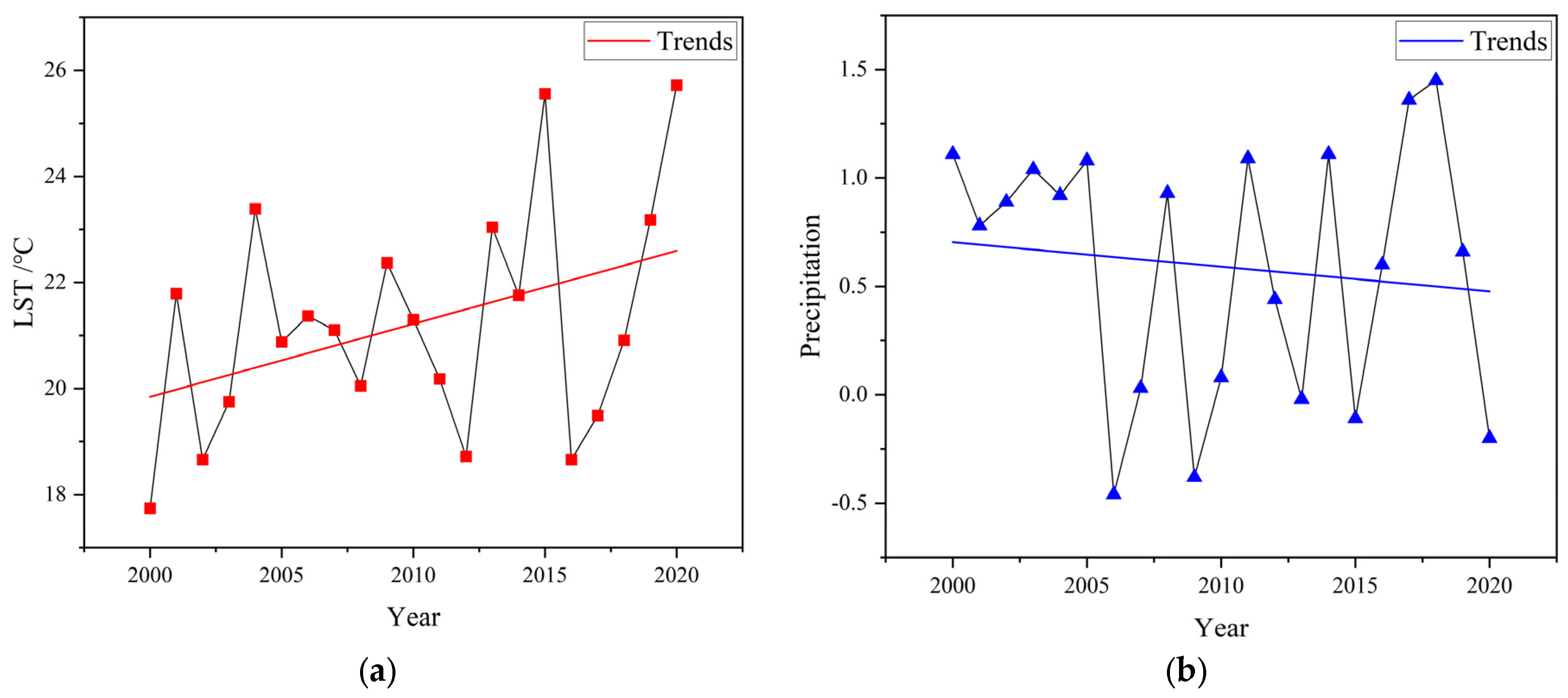
| Datasets | Level | Spatial Resolution (m) | Temporal Resolution (d) | Years |
|---|---|---|---|---|
| MOD13A1 | L3 | 500 m | 16 | 2000, 2005, 2010, 2015, 2020 |
| MOD11A2 | L3 | 1000 m | 8 | |
| MOD09A1 | L2 | 500 m | 8 | |
| MCD12Q1 | L3 | 500 m | 365 |
| Year | Indicators | PC1 | PC2 | PC3 | PC4 |
|---|---|---|---|---|---|
| 2000 | NDVI | 0.1106 | −0.7938 | 0.2869 | −0.5247 |
| LST | −0.1068 | 0.1225 | −0.7633 | −0.6252 | |
| WET | 0.5733 | −0.5373 | −0.3955 | 0.4756 | |
| SI | −0.8048 | −0.2574 | −0.4225 | 0.3279 | |
| Eigenvalue | 0.0418 | 0.0087 | 0.0048 | 0.0000 | |
| Percent eigenvalue | 75.59% | 15.73% | 8.68% | 0% | |
| 2005 | NDVI | 0.1860 | −0.7074 | 0.6375 | −0.2422 |
| LST | −0.0715 | −0.3375 | −0.6519 | −0.6753 | |
| WET | 0.1588 | 0.6182 | 0.3868 | −0.6656 | |
| SI | −0.9670 | −0.0595 | 0.1379 | −0.2059 | |
| Eigenvalue | 0.0328 | 0.0093 | 0.0026 | 0.0013 | |
| Percent eigenvalue | 71.30% | 20.22% | 5.65% | 2.83% | |
| 2010 | NDVI | 0.1288 | −0.5945 | −0.0486 | −0.7922 |
| LST | −0.1548 | 0.4790 | −0.7961 | −0.3358 | |
| WET | −0.2921 | 0.6446 | 0.5287 | −0.4686 | |
| SI | −0.9350 | 0.0402 | 0.2903 | −0.2000 | |
| Eigenvalue | 0.0356 | 0.0100 | 0.0042 | 0.0000 | |
| Percent eigenvalue | 71.46% | 20.09% | 8.45% | 0% | |
| 2015 | NDVI | 0.0892 | −0.5208 | −0.2815 | −0.8100 |
| LST | −0.1519 | 0.5811 | −0.7909 | −0.1168 | |
| WET | 0.1378 | 0.6233 | 0.5159 | −0.5713 | |
| SI | −0.9747 | −0.0501 | 0.1704 | −0.1359 | |
| Eigenvalue | 0.0441 | 0.0045 | 0.0037 | 0.0000 | |
| Percent eigenvalue | 84.40% | 8.54% | 7.06% | 0% | |
| 2020 | NDVI | 0.1517 | −0.7458 | 0.3500 | −0.5461 |
| LST | −0.0332 | −0.0752 | −0.8789 | −0.4698 | |
| WET | 0.2085 | −0.6613 | −0.2885 | 0.6603 | |
| SI | −0.9656 | −0.0282 | −0.1475 | 0.2122 | |
| Eigenvalue | 0.0388 | 0.0027 | 0.0045 | 0.0000 | |
| Percent eigenvalue | 84.35% | 5.87% | 9.78% | 0% |
| RSEI Level | 2000 | 2005 | 2010 | 2015 | 2020 | |||||
|---|---|---|---|---|---|---|---|---|---|---|
| Area (km2) | Pct. (%) | Area (km2) | Pct. (%) | Area (km2) | Pct. (%) | Area (km2) | Pct. (%) | Area (km2) | Pct. (%) | |
| Poor | 59,464 | 16.40% | 134,978.25 | 37.24% | 184,808.5 | 50.98% | 64,869.5 | 17.90% | 64,869.5 | 17.90% |
| Fair | 225,199 | 62.13% | 168,907.75 | 46.60% | 157,104 | 43.34% | 222,360.75 | 61.34% | 222,360.75 | 61.34% |
| Moderate | 63,021 | 17.39% | 51,935.75 | 14.33% | 14,565.75 | 4.02% | 66,235.5 | 18.27% | 66,235.5 | 18.27% |
| Good | 11,178.75 | 3.08% | 6393.75 | 1.76% | 4601.75 | 1.27% | 7711 | 2.13% | 7711 | 2.13% |
| Excellent | 3627.5 | 1.00% | 274.75 | 0.08% | 1410.25 | 0.39% | 1313.5 | 0.36% | 1313.5 | 0.36% |
| 2000 | |||||||||||
|---|---|---|---|---|---|---|---|---|---|---|---|
| Poor | Fair | Moderate | Good | Excellent | |||||||
| Area (km2) | Pct. (%) | Area (km2) | Pct. (%) | Area (km2) | Pct. (%) | Area (km2) | Pct. (%) | Area (km2) | Pct. (%) | ||
| 2005 | Poor | 45,035.75 | 75.74 | 85,664.75 | 38.04 | 4264 | 6.77 | 13.75 | 0.12 | 0 | 0.00 |
| Fair | 13,420 | 22.57 | 115,905.5 | 51.47 | 35,698.25 | 56.65 | 3682.25 | 32.94 | 201.75 | 5.56 | |
| Moderate | 970.5 | 1.63 | 22,382.25 | 9.94 | 21,094.75 | 33.47 | 5740 | 51.35 | 1748.25 | 48.19 | |
| Good | 37.75 | 0.06 | 1225.5 | 0.54 | 1949.75 | 3.09 | 1660 | 14.85 | 1520.75 | 41.92 | |
| Excellent | 0 | 0.00 | 21 | 0.01 | 14.25 | 0.02 | 82.75 | 0.74 | 156.75 | 4.32 | |
| Change | 14,428.25 | 24.26 | 109,293.5 | 48.53 | 41,926.25 | 66.53 | 9518.75 | 85.15 | 3470.75 | 95.68 | |
| 2005 | |||||||||||
|---|---|---|---|---|---|---|---|---|---|---|---|
| Poor | Fair | Moderate | Good | Excellent | |||||||
| Area (km2) | Pct. (%) | Area (km2) | Pct. (%) | Area (km2) | Pct. (%) | Area (km2) | Pct. (%) | Area (km2) | Pct. (%) | ||
| 2010 | Poor | 103,053 | 76.35 | 71,197.75 | 42.15 | 10,232.75 | 19.70 | 325 | 5.08 | 0 | 0.00 |
| Fair | 31,481.25 | 23.32 | 90,623 | 53.65 | 32,049.75 | 61.71 | 2903 | 45.40 | 47 | 17.11 | |
| Moderate | 421.75 | 0.31 | 5703.25 | 3.38 | 6658.5 | 12.82 | 1667.5 | 26.08 | 114.75 | 41.77 | |
| Good | 21.75 | 0.02 | 1249.5 | 0.74 | 2221.75 | 4.28 | 1025 | 16.03 | 83.75 | 30.48 | |
| Excellent | 0.5 | 0.00 | 134.25 | 0.08 | 773 | 1.49 | 473.25 | 7.40 | 29.25 | 10.65 | |
| Change | 31,925.25 | 23.65 | 78,284.75 | 46.35 | 45,277.25 | 87.18 | 5368.75 | 83.97 | 245.5 | 89.35 | |
| 2010 | |||||||||||
|---|---|---|---|---|---|---|---|---|---|---|---|
| Poor | Fair | Moderate | Good | Excellent | |||||||
| Area (km2) | Pct. (%) | Area (km2) | Pct. (%) | Area (km2) | Pct. (%) | Area (km2) | Pct. (%) | Area (km2) | Pct. (%) | ||
| 2015 | Poor | 52,092.25 | 28.19 | 12,586.25 | 8.01 | 185.5 | 1.27 | 5.5 | 0.12 | 0 | 0.00 |
| Fair | 114,059 | 61.72 | 101,867.5 | 64.84 | 5817.25 | 39.94 | 579 | 12.58 | 38 | 2.69 | |
| Moderate | 18,240.25 | 9.87 | 39,823 | 25.35 | 6288.75 | 43.17 | 1646.25 | 35.77 | 237.25 | 16.82 | |
| Good | 417 | 0.23 | 2773.75 | 1.77 | 2081.5 | 14.29 | 1847 | 40.14 | 591.75 | 41.96 | |
| Excellent | 0 | 0.00 | 53.5 | 0.03 | 192.75 | 1.32 | 524 | 11.39 | 543.25 | 38.52 | |
| Change | 132,716.3 | 71.81 | 55,236.5 | 35.16 | 8277 | 56.83 | 2754.75 | 59.86 | 867 | 61.48 | |
| 2015 | |||||||||||
|---|---|---|---|---|---|---|---|---|---|---|---|
| Poor | Fair | Moderate | Good | Excellent | |||||||
| Area (km2) | Pct. (%) | Area (km2) | Pct. (%) | Area (km2) | Pct. (%) | Area (km2) | Pct. (%) | Area (km2) | Pct. (%) | ||
| 2020 | Poor | 31,021.25 | 47.82 | 30,303.75 | 13.63 | 3012.25 | 4.55 | 15.75 | 0.20 | 0 | 0.00 |
| Fair | 31,430.5 | 48.45 | 147,767.8 | 66.45 | 35,955 | 54.28 | 1063.75 | 13.80 | 0 | 0.00 | |
| Moderate | 2241.75 | 3.46 | 37,880 | 17.04 | 19,978.25 | 30.16 | 2921.25 | 37.88 | 45.25 | 3.44 | |
| Good | 171.75 | 0.26 | 6077.75 | 2.73 | 6605.5 | 9.97 | 2988 | 38.75 | 536.25 | 40.83 | |
| Excellent | 4.25 | 0.01 | 331.5 | 0.15 | 684.5 | 1.03 | 722.25 | 9.37 | 732 | 55.73 | |
| Change | 33,848.25 | 52.18 | 74,593 | 33.55 | 46,257.25 | 69.84 | 4723 | 61.25 | 581.5 | 44.27 | |
Disclaimer/Publisher’s Note: The statements, opinions and data contained in all publications are solely those of the individual author(s) and contributor(s) and not of MDPI and/or the editor(s). MDPI and/or the editor(s) disclaim responsibility for any injury to people or property resulting from any ideas, methods, instructions or products referred to in the content. |
© 2023 by the authors. Licensee MDPI, Basel, Switzerland. This article is an open access article distributed under the terms and conditions of the Creative Commons Attribution (CC BY) license (https://creativecommons.org/licenses/by/4.0/).
Share and Cite
Peng, X.; Zhang, S.; Peng, P.; Chen, A.; Li, Y.; Wang, J.; Bai, M. Unraveling the Ecological Tapestry: A Comprehensive Assessment of Changtang Nature Reserve’s Ecological and Environmental Using RSEI and GEE. Land 2023, 12, 1581. https://doi.org/10.3390/land12081581
Peng X, Zhang S, Peng P, Chen A, Li Y, Wang J, Bai M. Unraveling the Ecological Tapestry: A Comprehensive Assessment of Changtang Nature Reserve’s Ecological and Environmental Using RSEI and GEE. Land. 2023; 12(8):1581. https://doi.org/10.3390/land12081581
Chicago/Turabian StylePeng, Xuefeng, Shiqi Zhang, Peihao Peng, Ailin Chen, Yang Li, Juan Wang, and Maoyang Bai. 2023. "Unraveling the Ecological Tapestry: A Comprehensive Assessment of Changtang Nature Reserve’s Ecological and Environmental Using RSEI and GEE" Land 12, no. 8: 1581. https://doi.org/10.3390/land12081581
APA StylePeng, X., Zhang, S., Peng, P., Chen, A., Li, Y., Wang, J., & Bai, M. (2023). Unraveling the Ecological Tapestry: A Comprehensive Assessment of Changtang Nature Reserve’s Ecological and Environmental Using RSEI and GEE. Land, 12(8), 1581. https://doi.org/10.3390/land12081581









